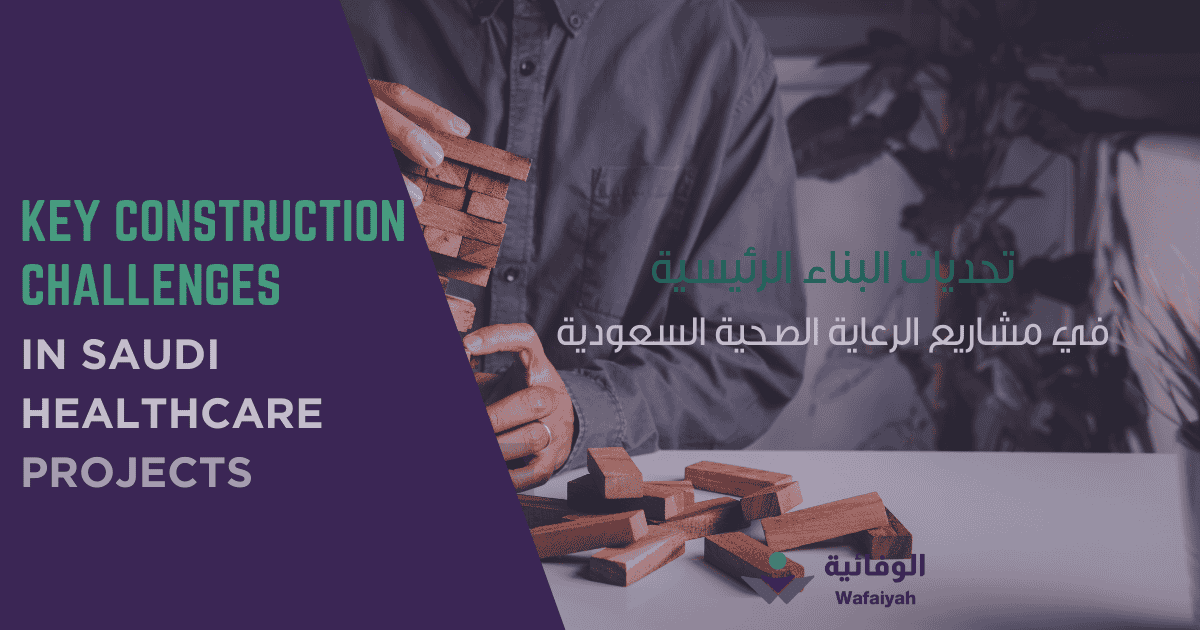Saudi Arabia’s healthcare sector is rapidly growing as part of Vision 2030, which aims to provide excellent medical services for its people. The country is rising in demand for hospitals, clinics, and advanced medical cities, creating both opportunity and urgency in infrastructure development. Meeting these goals requires addressing complex construction challenges while ensuring the highest standards of care. In this guide, Wafaiyah explores the key obstacles shaping healthcare projects and the practical solutions driving successful delivery.
The process of constructing hospitals in Saudi Arabia is complex due to the strict regulations and approvals. All the processes, including the design, construction, and even the closure, require government approval, which is a long process. New medical equipment or building materials require additional certifications for the hospital to use them. The building should be constructed according to the Saudi Building Codes as well as the Ministry of Health regulations. Similarly, the hospitals must also address international standards such as JCI, NFPA, and FGI. Complying with both local and international regulations may result in delay over documentation, redesigns, additional cost or even the substitution of materials. As a precautionary measure, the stakeholders (government, designers, investors) should be involved early on. Store all major records and monitor compliance to prevent delays.
High-Cost Budgeting and Financial Issues
Hospital construction is costly because it requires advanced medical equipment and strong infrastructure. Costs can increase due to delays or sudden changes in material prices. In Saudi Arabia, most healthcare projects are funded by the government, and the money depends on oil prices. When oil prices drop, budgets can shrink. Public-Private Partnerships (PPPs) are also tricky, as investors want clear rules on how risks and profits are shared. To control costs, projects need transparent procurement, proper budgeting, and strong financial planning. This helps prevent waste and ensures projects continue even during tough economic times.
Shortage of Skilled Workforce & Labour Challenge
Construction of hospitals requires highly specialized workers. They should be skilled in handling medical gas appliances or medical gas systems, as well as advanced electrical work. Saudi Arabia has a shortage of talent in these fields. This has forced the government to import professional managers and engineers from abroad. Within the vision of 2030, the focus should be on training and employing more local labour. Thus, long projects continue to have trouble retaining skilled workers. This can be resolved by companies having long-term strategies, constant training and immediate career growth opportunities to maintain talent.
Complexities in Technological & Design Work
Modern hospitals require high-tech systems that are beyond traditional construction. They require HVAC systems that control infections, fire safety networks, and medical gas pipelines. Moreover, monitoring systems based on IoT, artificial intelligence, and digital health solutions help with the hospital design to facilitate smart hospital delivery. Building Information Modelling (BIM) also comes with its benefits and challenges. It improves coordination and reduces errors. On the other hand, it needs trained staff to adopt the whole system better. Flexible and modular hospital facilities are also necessary to cover future hospital requirements. Meeting these technological needs requires a powerful collaboration with architecture, engineers and hospital experts.
Challenges of Supply Chain & Material Procurement
Medical construction is based on special medical materials and equipment, and most of them are imported. This raises the danger of delays because of customs clearance or issues in the supply chains. There is also the case of logistical problems of transporting equipment in remote locations, which is likely to make the project time longer. Meanwhile, there are also budget uncertainties due to changes in prices of raw materials such as steel and cement. In resolving such challenges, Saudi Arabia has a Vision 2030 that focuses on localizing supply chains and promoting local production of critical medical equipment. Good planning of procurement and strong relations with suppliers can avoid costly delays and allow the timely delivery of the project.
Climate & Environmental Problems to Tackle
The desert climate of Saudi Arabia has a significant influence on hospital construction works. The high temperatures and sandstorms reduce the process of construction and pose an additional hazard to workers. Hospitals also need energy-intensive infrastructure design.
Moreover, the issue of water scarcity poses a significant problem in planning hospital activities since hospitals use a lot of water every day. To handle these issues, developers are increasingly choosing the concept of green building. This concept involves smart insulation, the use of solar energy and water recycling systems.
The country is committed to environmentally responsible healthcare, with some new hospitals seeking international sustainability certification, including LEED. The practices are not only efficient but also environmentally friendly.
Handling Project Management & Coordination Challenges
Hospital construction projects are highly complex, involving multiple stakeholders including government authorities, contractors, consultants, and international suppliers. Managing such large-scale projects requires precise coordination across all phases.
In Saudi Arabia, mega hospital projects are usually developed in stages. This increases the need for precise scheduling and seamless handovers. Multicultural teams bring valuable expertise but may also face communication barriers that slow decision-making. Poor project scheduling or inadequate risk management can lead to costly delays.
To address this, advanced project management tools such as digital dashboards, BIM integration, and real-time reporting are best used. They track progress and enhance accountability. Strong leadership, transparent communication, and smooth workflows are essential to keep these mega hospital projects on track.
Essential Strategies to Overcome Healthcare Challenges
The process of constructing successful hospital projects in Saudi Arabia demands smart approaches that are much better than modern ways. One of the most significant steps is digital transformation. Planning is easier with the help of tools, including Building Information Modelling (BIM), artificial intelligence, and contemporary project tracking systems that reduce errors and time.
Another vital role is played by Public-Private Partnerships (PPP). It combines the governmental backing and the expertise of the private sector and offers projects with funds and innovations. Training and localization of workforce are also essential to produce qualified specialists who will be able to run complex health organizations.
The sustainable approaches to construction assist in the acceleration of delivery, but also maintain the cost within a reasonable range and fulfil the environmental objectives. Finally, good supply chain relationships, which local suppliers and consistent procurement procedures reinforce, contribute to a decrease in delays. The combination of these strategies forms an obvious route for delivering world-class facilities in Saudi Arabia.
Conclusion
With proactive planning and innovative approaches, these obstacles can be transformed into opportunities for growth. Achieving this vision requires close collaboration between government, investors, and contractors. At Wafaiyah, we remain committed to supporting these efforts and contributing to Saudi Arabia’s healthcare transformation.
Frequently Asked Questions
What makes healthcare construction projects in Saudi Arabia unique?
They require specialized facilities, strict compliance with global standards, and integration of advanced technology, unlike general construction.
Why are healthcare projects in Saudi Arabia often delayed?
Delays arise from regulatory approvals, supply chain bottlenecks, and a shortage of skilled professionals.
How does Vision 2030 impact hospital construction?
Vision 2030 drives large-scale investments in healthcare infrastructure, boosting demand but also intensifying challenges in execution.
What role does sustainability play in Saudi hospital construction?
Hospitals must address energy efficiency, water conservation, and green building requirements to align with national sustainability goals.

